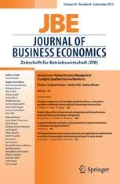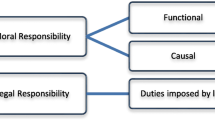Abstract
Voluntary agreements in which competitors commit to common goals are important tools for corporate social responsibility. After entering into a commitment, however, competitors often have incentives to behave opportunistically. This is possible because voluntary agreements are not enforced by external sanctions. We present the results of an exploratory laboratory experiment that investigates the behavior of competitors engaging in commitments and consequently the effectiveness of such measures. We find that introducing a publicly visible commitment device that is implemented with a low probability mitigated conflict between competitors substantially. Our results show that subjects’ inclination to defect one another after competition was mainly driven by the opponents’ refusal to enter into a commitment. In our experiment, a commitment was not used to trick the competitor into a false sense of security but rather to convey the truth about subjects’ moral behavior. We conclude that the efforts of (non-)governmental institutions to reinforce trust between competitors may be of substantial value.


Similar content being viewed by others
Notes
See, for instance, European Commission (2006), “Corporate Social Responsibility in the EU”, http://www.eubusiness.com/topics/social/corporate-social-responsibility-in-the-eu. Accessed 15 June 2016.
A coordination game is a situation where two players get the highest payoffs if they manage to choose the same strategy. A game of conflict is a situation where increasing the payoff of one player implies decreasing the payoff of the other.
The 17 subjects for whom the commitment choice was implemented are not of interest, as their money burning was zero by definition.
We used a Mann–Whitney U test due to the small number of self-committers who encountered opponents who refused to use the commitment option.
See World Value Survey (2015), “Trust”, http://www.worldvaluessurvey.org/WVSOnline.jsp. Accessed 15 June 2016.
References
Arimura TH, Hibiki A, Katayama H (2008) Is a voluntary approach an effective environmental policy instrument? A case for environmental management systems. J Environ Econ Manag 55(3):281–295
Arnett JJ (2005) Talk is cheap: the tobacco companies’ violations of their own cigarette advertising code. J Health Commun 10(5):419–431
Batson CD, Thompson ER, Chen H (2002) Moral hypocrisy: addressing some alternatives. J Pers Soc Psychol 83(2):330–339
Bazerman MH, Tenbrunsel AE (2011) Blind spots: why we fail to do what’s right and what to do about it. Princeton University Press, Princeton
Blackman A (2008) Can voluntary environmental regulation work in developing countries? Lessons from case studies. Policy Stud J 36(1):119–141
Coglianese C, Nash J (2016) Motivating without mandates: the role of voluntary programs in environmental governance. In: Paddock L, Glicksman R, Bryner NS (eds) Elgar Encyclopedia of Environmental Law: decisionmaking in environmental law. Elgar, Cheltenham, pp 16–114
Dahlsrud A (2008) How corporate social responsibility is defined: an analysis of 37 definitions. Corp Soc Responsib Environ Manag 15:1–13
Dixit AK, Nalebuff BJ (1993) Thinking strategically: the competitive edge in business, politics, and everyday life. WW Norton & Company, New York
European Commission (2006) Corporate Social Responsibility in the EU. http://www.eubusiness.com/topics/social/corporate-social-responsibility-in-the-eu
Farrell J, Rabin M (1996) Cheap talk. J Econ Perspect 10(3):103–118
Franco-Garc´ıa ML, Sosa A, Bressers HTA (2012) A dynamic analysis of voluntary agreement implementation in Mexico. J Publ Aff 12(3):239–249
Gamper-Rabindran S, Finger SR (2013) Does industry self-regulation reduce pollution? Responsible care in the chemical industry. J Regul Econ 43(1):1–30
Greiner B (2004) An online recruitment system for economic experiments. In: Kremer K, Macho V (eds) Forschung und Wissenschaftliches Rechnen, Ges. fu¨r wiss. Datenverabeitung, Gottingen, 79–93
Homann K (2015) Wirtschaftsethik: Ethik, rekonstruiert mit ökonomischer Methode. In: van Aaken D, Schreck P (eds) Theorien der Wirtschafts-und Unternehmensethik. Suhrkamp Verlag, Berlin
Jauernig J, Uhl M, Luetge C (2016) Competition-induced punishment of winners and losers: who is the target? J Econ Psychol 57:13–25
Lange I (2009) Evaluating voluntary measures with treatment spillovers: the case of coal combustion products partnership. BE J Econ Anal Policy 9(1):1–22
Richards JW, Tye JB, Fischer PM (1996) The tobacco industry’s code of advertising in the United States: myth and reality. Tob Control 5(4):295–311
Rietbergen MG, Farla JC, Blok K (2002) Do agreements enhance energy efficiency improvement?: Analysing the actual outcome of long-term agreements on industrial energy efficiency improvement in the Netherlands. J Clean Prod 10(2):153–163
Schelling T (1960) The strategy of conflict. Harvard University Press, Cambridge
Segerson K (2013) When is reliance on voluntary approaches in agriculture likely to be effective? Appl Econ Perspect Policy 35(4):565–592
Segerson K, Miceli TJ (1998) Voluntary environmental agreements: good or bad news for environmental protection? J Environ Econ Manag 36:109–130
Tajfel H, Turner JC (1979) An integrative theory of intergroup conflict. Soc Psychol Intergr Relat 33(47):74
Vanberg C (2008) Why do people keep their promises? An experimental test of two explanations. Econometrica 76(6):1467–1480
World Value Survey (2015) Trust. http://www.worldvaluessurvey.org/WVSOnline.jsp
Author information
Authors and Affiliations
Corresponding author
Ethics declarations
Conflict of interest
The authors declare that they have no conflict of interest.
Funding
This study was funded by the Technical University of Munich.
Disclosure
The authors confirm that they have reported all measures, conditions, data exclusions, and how they determined their sample sizes.
Ethical approval
All procedures performed in studies involving human participants were in accordance with the ethical standards of the institutional and/or national research committee and with 1964 Helsinki declaration and its later amendments or comparable ethical standards.
Informed consent
Informed consent was obtained from all individual participants included in the study.
Additional information
The authors thank Klaus Abbink, Jan Gogoll, Bernd Irlenbusch, Bettina Rockenbach and Dirk Sliwka for helpful comments as well as Simon Bierbaum for programming.
Appendix: Instructions (translated from German)
Appendix: Instructions (translated from German)
Welcome to this experiment, and thank you very much for your participation!
At the beginning of the experiment, every participant is assigned a letter from A to X. Every letter is assigned only once. Participants keep their letters until the end of the experiment. Letters are allocated randomly and remain anonymous.
This experiment consists of two parts. The first part consists of 19 calculation tasks, which you have to play out against another participant from this room. This participant is randomly assigned to you. In each round, you are presented with a matrix. Every matrix consists of 16 cells. In each cell is a one-digit number with one decimal place. Per matrix, there are exactly two pairs of numbers that add up to 10. All participants receive the same matrices in identical order. In each matrix presented, you have to click on ONE of the two pairs that add up to 10.
The participant who is assigned to you gets to see the same matrix simultaneously. He or she, too, has to find one pair as quickly as possible. As soon as the faster one has marked two cells, the slower one can no longer click on the cells, and the round is over. If the chosen pair of numbers is right, the faster one scores. If the faster one chooses a wrong combination, the slower one scores. Your score and the score of the participant assigned to you remain displayed at top of the screen and constantly adapt to the state of play.
If one round is finished, after three seconds, you are presented with the next matrix until all 19 rounds are completed. In case you or the other participant does not click on any cells, there is a time-out after 45 s, and the next matrix is presented. In the case of a draw after 19 rounds, a drawing of lots with equal probabilities decides who the winner and who the loser is. Both scores are displayed at the top of the screen. The first part is then completed.
In the second part of the experiment, each participant is financially endowed with 100 ECU (experimental currency units). This endowment can be altered during the experiment. At the end of the Experiment, your gains are converted into Euros and are disbursed to you in private. The exchange rate is as follows: 10 ECU = 70 Euro cents.
For the second part of the experiment, each participant remains assigned to the participant whom he played against in the first part. Both participants simultaneously get the opportunity to reduce their counterpart’s endowment of 100 ECU by any integer amount down to a minimum of 0 ECU. This reduction does not influence their own endowment. Likewise each participant can leave the counterparts’ endowments unchanged. The possible reduction of the endowments by the assigned participants come into effect with different probabilities for winners and loser from the first part of the experiment:
As you can see, there are 4 black and 6 white balls in the winner’s urn. In the loser’s urn, the condition is reversed: Herein contained are 6 black and only 4 white balls.
In case a black ball is drawn from a participant’s urn, he gets hit by the decision of his counterpart. His endowment is then reduced or left untouched according to the decision of the counterpart. If, however, a white ball is drawn, the decision of the counterpart is ignored. Consequently, the participant’s endowment is left untouched irrespective of the decision of the counterpart.
Winners bear a risk of 40% of being hit with the counterpart’s decision. Losers bear a risk of 60% of being hit with the counterpart’s decision. The drawings from both urns take place simultaneously. Hence both, one, or no decision can come into effect.
Before the screen with the option of reducing the endowment of the respective counterpart is shown, you and your counterpart may unilaterally exclude this possibility. You and your counterpart make this choice simultaneously, and both choices are communicated to you and your counterpart. Whether your choice and the choice of your counterpart to forgo the reduction option will be binding is decided by a random draw. In 2 of 10 cases, the reduction button will actually become inactive. In 8 of 10 cases, you will still be able to reduce the endowment of your counterpart. Subsequently, you and your counterpart will then receive the option of reducing the endowment of the other or not.
Subsequently, both participants receive their pay-off in Euro according to the decision of their counterpart and the result of the drawing from the urn. You will receive the individual pieces of information that are relevant to your decisions during the experiment.
If you completed reading and understood the instructions, please confirm by clicking on the accordant button on your screen. The instructions are then read out aloud once more. If you have any questions, please stand at your place and raise your hand.
Rights and permissions
About this article
Cite this article
Jauernig, J., Uhl, M. & Luetge, C. Voluntary agreements between competitors: trick or truth?. J Bus Econ 87, 1173–1191 (2017). https://doi.org/10.1007/s11573-017-0862-8
Published:
Issue Date:
DOI: https://doi.org/10.1007/s11573-017-0862-8




